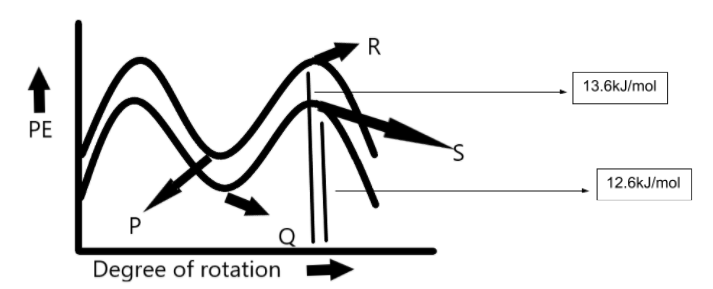
Answer
448.5k+ views
Hint: To answer this question, you should recall the concept of Conformational isomerism. It involves rotation about sigma bonds and does not involve any differences in the connectivity of the atoms or geometry of bonding. Two or more structures that are categorized as conformational isomers, or conformers, are just two of the same molecules that differ only in the rotation of one or more sigma bonds.
Complete step by step answer:
Alkanes can thus have an infinite number of conformations by rotation around carbon bonds. However, this rotation is not completely free due to repulsive interactions between the electron clouds of carbon-hydrogen bonds. This repulsive interaction is termed as torsional strain. The eclipsed conformation of ethane is represented by point S. This conformation has maximum potential energy but it is lower than the eclipsed conformation of propane. The staggered conformation of propane is represented by point P. It has the lowest potential energy but it is higher than the potential energy of staggered conformation of ethane.
Propane has more conformational energy as compared to ethane. Eclipsed conformation of ethane has more Vander Val strain and torsional strain so it lies to the upper side in the P.E. diagram and staggered conformation of propane has less Vander Val strain and torsional strain so it lies to the lower side in P.E. diagram.
Hence, the correct answer to this question is option C.
Note:
You should note that unhindered rotations do not exist in Ethane because the carbon-carbon bond is not completely free to rotate due to the torsional strain in ethane creating a barrier to the rotation that must be overcome for the bond to rotate from one staggered conformation to another. This rotational barrier is not large enough to prevent rotation except at extremely cold temperatures.
Complete step by step answer:
Alkanes can thus have an infinite number of conformations by rotation around carbon bonds. However, this rotation is not completely free due to repulsive interactions between the electron clouds of carbon-hydrogen bonds. This repulsive interaction is termed as torsional strain. The eclipsed conformation of ethane is represented by point S. This conformation has maximum potential energy but it is lower than the eclipsed conformation of propane. The staggered conformation of propane is represented by point P. It has the lowest potential energy but it is higher than the potential energy of staggered conformation of ethane.
Propane has more conformational energy as compared to ethane. Eclipsed conformation of ethane has more Vander Val strain and torsional strain so it lies to the upper side in the P.E. diagram and staggered conformation of propane has less Vander Val strain and torsional strain so it lies to the lower side in P.E. diagram.
Hence, the correct answer to this question is option C.
Note:
You should note that unhindered rotations do not exist in Ethane because the carbon-carbon bond is not completely free to rotate due to the torsional strain in ethane creating a barrier to the rotation that must be overcome for the bond to rotate from one staggered conformation to another. This rotational barrier is not large enough to prevent rotation except at extremely cold temperatures.
Recently Updated Pages
Identify the feminine gender noun from the given sentence class 10 english CBSE

Your club organized a blood donation camp in your city class 10 english CBSE

Choose the correct meaning of the idiomphrase from class 10 english CBSE

Identify the neuter gender noun from the given sentence class 10 english CBSE

Choose the word which best expresses the meaning of class 10 english CBSE

Choose the word which is closest to the opposite in class 10 english CBSE

Trending doubts
Fill the blanks with the suitable prepositions 1 The class 9 english CBSE

Which are the Top 10 Largest Countries of the World?

How do you graph the function fx 4x class 9 maths CBSE

The Equation xxx + 2 is Satisfied when x is Equal to Class 10 Maths

Difference between Prokaryotic cell and Eukaryotic class 11 biology CBSE

Change the following sentences into negative and interrogative class 10 english CBSE

Give 10 examples for herbs , shrubs , climbers , creepers

Why is there a time difference of about 5 hours between class 10 social science CBSE

Distinguish between Conventional and nonconventional class 9 social science CBSE





